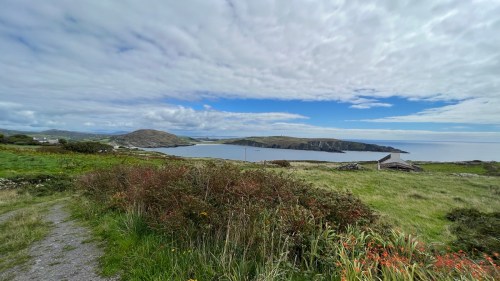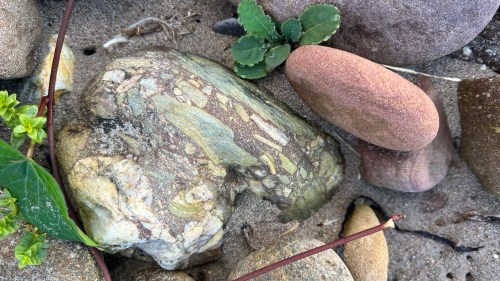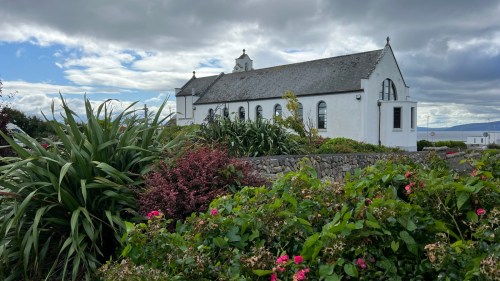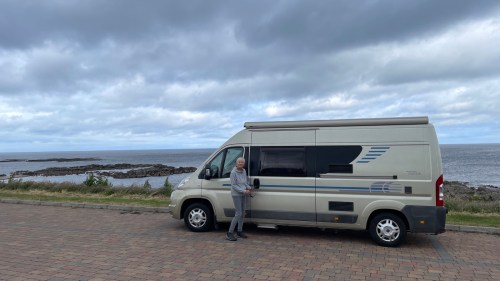Slea Head Drive on the Dingle peninsula was gorgeous but we weren’t permitted to complete the circuit via the dizzying and beautiful Conor Pass because of a weight restriction. No campervans or motorhomes allowed.
We reluctantly retraced our route (a Rule#1 violation: Never Go Backwards) to our home for the night, a quiet memorial park along the River Maine in the tiny village of Castlemaine. We had a bit of a think on our strategy for the next few weeks, aware that the consistently bad weather in July set us back a lot. We now have only about six weeks left before we need to leave the country, lots of Ireland still to see, decisions to make for where to go over the winter months, and figuring out where to store the van while we’re away. We both suffer from Planning Resistance so it wasn’t an easy discussion. We generally live by the Baba Ram Dass philosophy: Be Here Now.


In the end we made the shocking decision to skip the Ring of Kerry completely and drive right across the Beara peninsular via the Caha Pass, recommended by our Irish friend Gordon, and also skip the higher Healy Pass and continue to Bantry. We love mountain passes in general and some of our best memories are of thrilling high altitude scenic drives but they’re lots less fun in a campervan than in a zippy little car. And we certainly aren’t suffering from a deficit of dazzling scenery, regardless of where we go.
In Kenmare we stopped for groceries. I haven’t mentioned before but nearly every supermarket of any size has a dedicated section like this one. We learned there are about 100,000 Polish people living here, and Ireland has accepted more than 80,000 Ukrainian refugees so far. The array of regional comfort foods shows how much the Irish do to make them feel welcome.
On the other hand, ketchup flavored Cheetos is just wrong.



Our parkup gave us a stunning valley view across from Molly Gallivans Visitors Center, and we got a vivid sunset to boot.




The Caha Pass goes through three tunnels hand-chiseled through solid rock. We are small as campervans go, but I imagine the driver of a larger motorhome would be holding his or her breath driving through the tunnels despite the reassurance of the road signs.




For once there are places to pull off the road and take in the scenery. We must have taken fifty photos along the road, each view as pretty as the last.



We are people who like to go to the end of the road, any road, wherever it leads, and so we drove to the very end of Beara peninsula where we’d heard a cable car takes one across to Dursey Island, sticking way out in the Atlantic Ocean. You can’t go any further. That’s for us, we thought.

We saw the cable car as we approached but when we parked we realized it wasn’t moving. The food and coffee trucks we saw in photos were missing and the place was more or less deserted. Eventually we found a small sign informing us that the cable car was closed for repairs. How long it’s been closed or when it’ll reopen is anybody’s guess. We wished we’d known that before we drove all this way but it’s beautiful nonetheless and we learned about a dramatic 1881 rescue from the lighthouse at the memorial just up the road from the island.



For the second time in as many days we retraced our route along the coast and arrived at the cheerful little town of Bantry, where we were welcomed by St. Brendan and a rare municipal motorhome car park.


The motorhome aire gave us the opportunity to service the van without having to book into a campground, and we went to the movies for the first time in about five years.

Our good weather is predicted to continue for the coming week and we left Bantry on a mission to make the most of it. We are heading for a place that evokes awe and respect from sailors everywhere. It’s bucket list time again.













































































































































































